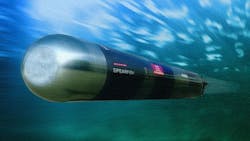BAE Systems chooses embedded computing from Abaco Systems for Spearfish torpedo
HUNTSVILLE, Ala., 16 Dec. 2015. Torpedo designers at BAE Systems needed rugged embedded computing to control the United Kingdom Royal Navy submarine-launched Spearfish heavyweight torpedo. They found their solution from Abaco Systems (formerly GE Intelligent Platforms) in Huntsville, Ala.
Officials of the BAE Systems Maritime Services business in Portsmouth, England, have place $11.5 million in orders with Abaco Systems for rugged embedded computing within the electronic system computer unit (ESCU) that controls the Spearfish torpedo in deployment, Abaco officials say.
The Abaco ESCU provides advanced real-time signal processing of the Spearfish's onboard sonar to enable it to reach its target, and networking to enable the torpedo to communicate with its host submarine.
The Spearfish ESCU has several 3U VPX Power Architecture- and 4th generation Intel Core i7-based single-board computers from Abaco Systems that provide control, tactical, and real-time digital signal processing. An Ethernet switch provides communications and networking.
Abaco Systems and BAE Systems experts worked together for five years to craft a feasibility study and prototype ESCU using a 6U VME architecture, Abaco Systems officials say. The team migrated to 3U VPX technology for torpedo deployment.
Related: Navy underwater warfare experts choose legacy memory PMC cards from GE for torpedo research
"Our ability to provide a solution that met the requirement for rugged high-performance embedded computing (HPEC) in an environment in which both space and power are constrained, and our ability to evolve our offering over the course of the last five years in response to BAE Systems' requirements were important factors in securing this business," explains Bernie Anger, CEO of Abaco Systems.
The order results from a $550 million order to BAE Systems from the United Kingdom Ministry of Defence to upgrade the Spearfish torpedo. The upgrade, known as Spearfish Mod 1, extends the life of the torpedo, and improves safety with an insensitive munitions warhead and a single-fuel system.
Upgrades also provide more capable data links between the torpedo and submarine. "The work we've undertaken with Abaco Systems over the last five years to develop the prototype ESCU will mean the Royal Navy will see a step-change in capability when the Mod-1 Spearfish Heavyweight Torpedo enters service," says Les Gregory, products and services director at BAE Systems. "Offering advanced real time signal processing of the torpedo's on-board sonar, plus improved communications between the torpedo and host vessel will ultimately make sure the torpedo reaches its intended destination, even in the most complex of scenarios."
The anti-submarine and anti-ship Spearfish torpedoes are deployed in the Royal Navy Trafalgar-, Vanguard-, and Astute-class submarines. The torpedo can operate autonomously from launch and is capable of variable speeds.
For more information contact Abaco Systems online at www.abaco.com, or BAE Systems Maritime Services at www.baesystems.com.

